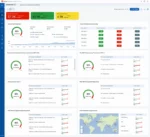
Buoyant, the company behind Linkerd, has introduced Linkerd Enterprise, a commercial distribution of Linkerd tailored for enterprise users.
It enhances the open-source Linkerd with features specific to enterprise needs, such as zero trust and FIPS 140-2 compliance, a sophisticated cost-aware load balancer, automation for lifecycle management, and additional functionalities to support enterprise adoption.
“Over the past 18 months, adoption of Linkerd in enterprise environments has skyrocketed, with companies like Adidas, Microsoft, Plaid, and DB Schenker all publishing case studies and talks about how they delivered security and reliability with Linkerd,” said William Morgan, Buoyant CEO and one of the creators of Linkerd. “We built Linkerd Enterprise in response to that surge in demand, to give the enterprise adopters the best of both worlds: all the features and capabilities of the world’s most advanced service mesh combined with the packaging, support, expertise, and unique features that are critical for running Linkerd in enterprise environments.”
For existing Linkerd adopters, Linkerd Enterprise is a drop-in upgrade for Linkerd. One of the new capabilities and features of Enterprise Linkerd is cloud spend reduction through advanced load balancing.
The load balancer in Linkerd Enterprise optimizes traffic routing by directing it to the most cost-effective region during regular operations. Only when the system experiences stress does it route traffic to more expensive regions. Unlike Kubernetes’ native topology-based routing, Linkerd’s request-balancing method offers both high availability and cost savings. It accommodates single-cluster and cross-cluster traffic, making it a cost-effective solution even for enterprises with complex application setups.
Another feature is Linkerd’s unique Rust-based “micro-proxy” approach that provides a fundamentally simpler operational model without the complexity found in other service meshes such as Istio.
Other features include zero trust security policy management, software bills-of-material (SBOMs), hardened images, and more.








